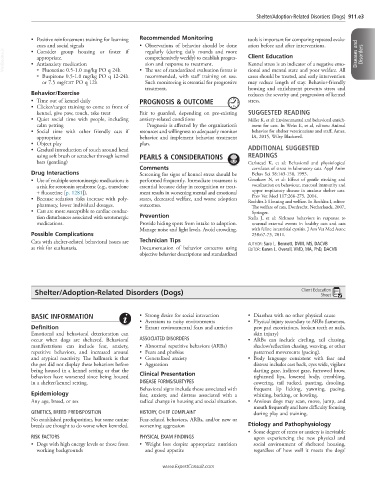Page 1821 - Cote clinical veterinary advisor dogs and cats 4th
P. 1821
Shelter/Adoption-Related Disorders (Dogs) 911.e3
• Positive reinforcement training for learning Recommended Monitoring tools is important for comparing repeated evalu-
cues and social signals • Observations of behavior should be done ation before and after interventions.
VetBooks.ir • Antianxiety medication comprehensively weekly) to establish progres- Client Education Diseases and Disorders
regularly (during daily rounds and more
• Consider group housing or foster if
appropriate.
Kennel stress is an indicator of a negative emo-
sion and response to treatment.
○ Fluoxetine 0.5-1.0 mg/kg PO q 24h
○ Buspirone 0.5-1.0 mg/kg PO q 12-24h • The use of standardized evaluation forms is tional and mental state and poor welfare. All
recommended, with staff training on use.
cases should be treated, and early intervention
or 7.5 mg/CAT PO q 12h Such monitoring is essential for progressive may reduce length of stay. Behavior-friendly
treatment. housing and enrichment prevents stress and
Behavior/Exercise reduces the severity and progression of kennel
• Time out of kennel daily PROGNOSIS & OUTCOME stress.
• Clicker/target training to come to front of
kennel, give paw, touch, take treat Fair to guarded, depending on pre-existing SUGGESTED READING
• Quiet social time with people, including anxiety-related conditions Miller K, et al: Environmental and behavioral enrich-
calm petting Prognosis is affected by the organization’s ment for cats. In Weiss E, et al, editors: Animal
• Social time with other friendly cats if resources and willingness to adequately monitor behavior for shelter veterinarians and staff, Ames,
appropriate behavior and implement behavior treatment IA, 2015, Wiley Blackwell.
• Object play plan.
• Gradual introduction of touch around head ADDITIONAL SUGGESTED
using soft brush or scratcher through kennel PEARLS & CONSIDERATIONS READINGS
bars (gentling) Carlstead K, et al: Behavioral and physiological
Comments correlates of stress in laboratory cats. Appl Anim
Drug Interactions Screening for signs of kennel stress should be Behav Sci 38:143-158, 1993.
• Use of multiple serotoninergic medications is performed frequently. Immediate treatment is Gourkow N, et al: Effect of gentle stroking and
a risk for serotonin syndrome (e.g., trazodone essential because delay in recognition or treat- vocalization on behaviour, mucosal immunity and
+ fluoxetine [p. 1281]). ment results in worsening mental and emotional upper respiratory disease in anxious shelter cats.
Prev Vet Med 117:266-275, 2014.
• Because sedation risks increase with poly- states, decreased welfare, and worse adoption Rochlitz I: Housing and welfare. In Rochlitz I, editor:
pharmacy, lower individual dosages. outcomes. The welfare of cats, Dordrecht, Netherlands, 2007,
• Cats are more susceptible to cardiac conduc- Springer.
tion disturbances associated with serotonergic Prevention Stella J, et al: Sickness behaviors in response to
medications. Provide hiding spots from intake to adoption. unusual external events in healthy cats and cats
Manage noise and light levels. Avoid crowding. with feline interstitial cystitis. J Am Vet Med Assoc
Possible Complications 238:67-73, 2011.
Cats with shelter-related behavioral issues are Technician Tips AUTHOR: Sara L. Bennett, DVM, MS, DACVB
at risk for euthanasia. Documentation of behavior concerns using EDITOR: Karen L. Overall, VMD, MA, PhD, DACVB
objective behavior descriptions and standardized
Shelter/Adoption-Related Disorders (Dogs) Client Education
Sheet
BASIC INFORMATION • Strong desire for social interaction • Diarrhea with no other physical cause
• Aversions to noisy environments • Physical injury secondary to ARBs (lameness,
Definition • Extant environmental fears and anxieties paw pad excoriations, broken teeth or nails,
Emotional and behavioral deterioration can skin injury)
occur when dogs are sheltered. Behavioral ASSOCIATED DISORDERS • ARBs can include circling, tail chasing,
manifestations can include fear, anxiety, • Abnormal repetitive behaviors (ARBs) shadow/reflection chasing, weaving, or other
repetitive behaviors, and increased arousal • Fears and phobias patterned movements (pacing).
and atypical reactivity. The hallmark is that • Generalized anxiety • Body language consistent with fear and
the pet did not display these behaviors before • Aggression distress includes ears back, eyes wide, vigilant
being housed in a kennel setting or that the Clinical Presentation darting gaze, indirect gaze, furrowed brow,
behaviors have worsened since being housed tightened lips, lowered body, trembling,
in a shelter/kennel setting. DISEASE FORMS/SUBTYPES cowering, tail tucked, panting, drooling,
Behavioral signs include those associated with frequent lip licking, yawning, pacing,
Epidemiology fear, anxiety, and distress associated with a whining, barking, or howling.
Any age, breed, or sex radical change in housing and social situation. • Anxious dogs may scan, move, jump, and
mouth frequently and have difficulty focusing
GENETICS, BREED PREDISPOSITION HISTORY, CHIEF COMPLAINT during play and training.
No established predisposition, but some canine Fear-related behaviors, ARBs, and/or new or
breeds are thought to do worse when kenneled. worsening aggression Etiology and Pathophysiology
• Some degree of stress or anxiety is inevitable
RISK FACTORS PHYSICAL EXAM FINDINGS upon experiencing the new physical and
• Dogs with high energy levels or those from • Weight loss despite appropriate nutrition social environment of sheltered housing,
working backgrounds and good appetite regardless of how well it meets the dogs’
www.ExpertConsult.com

